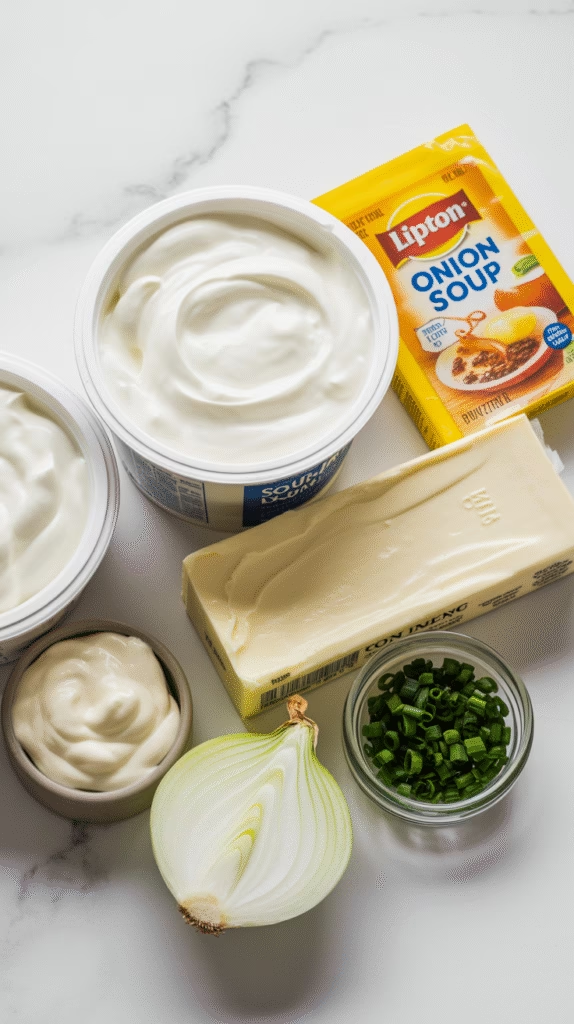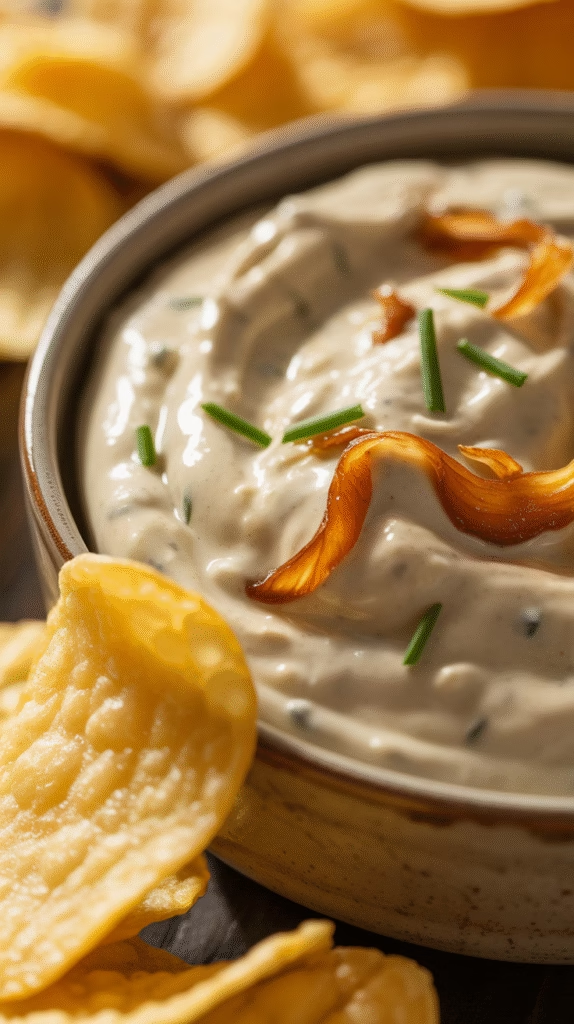Ever wonder why homemade French onion dip tastes so much better than the processed stuff? It’s because you control every ingredient, every flavor note, and most importantly—you actually use real onions. Revolutionary concept, right?
Why Make French Onion Dip From Scratch?
The Flavor Factor
Making your own French onion dip isn’t just about being fancy (though your friends will think you’re a culinary genius). Homemade dip delivers layers of flavor that store-bought versions can’t touch. When you caramelize those onions yourself, you create complex sweetness that pairs perfectly with the tangy sour cream base.
I learned this the hard way at a potluck disaster three years ago. I grabbed store-bought dip thinking nobody would notice. Wrong. My friend Sarah took one bite and asked if I’d accidentally brought expired dip. Ouch. That’s when I decided to master the art of proper French onion dip.
Control Your Ingredients
Here’s what really gets me excited about homemade dip—you know exactly what’s going into it. No mysterious preservatives, no artificial flavoring that tastes like onion’s distant cousin. Just real ingredients working together like they’re supposed to.
The best part? You can adjust the flavors to your liking. Want more onion bite? Add extra caramelized onions. Prefer it tangier? Bump up the sour cream ratio. It’s your dip, your rules.

Essential Ingredients for Perfect French Onion Dip
The Foundation Trio
These three ingredients form the holy trinity of French onion dip:
- Sour cream – Your creamy base that brings tang and richness
- Mayonnaise – Adds smoothness and helps bind everything together
- Caramelized onions – The star of the show, providing sweet and savory depth
The Flavor Enhancers
Don’t stop at the basics. These additions transform good dip into unforgettable dip:
- Cream cheese – Makes everything extra creamy (trust me on this one)
- Worcestershire sauce – Adds umami depth that’ll make people wonder what your secret is
- Garlic powder – Because garlic makes everything better
- Salt and pepper – The flavor amplifiers you can’t skip

Step-by-Step French Onion Dip Recipe
Caramelizing the Onions (The Make-or-Break Step)
This is where most people mess up, so pay attention. Proper caramelization takes time, and there’s no rushing it. I see people trying to speed this up on high heat all the time—don’t be that person.
Here’s my foolproof method:
- Slice 3 large yellow onions thinly (consistency matters here)
- Heat 2 tablespoons of butter in a large skillet over medium-low heat
- Add the onions with a pinch of salt and stir to coat
- Cook for 45-60 minutes, stirring every 10 minutes
Yeah, you read that right—45 to 60 minutes. I know it seems excessive, but this is what separates amateur dip from the good stuff. The onions should turn a beautiful golden-brown color and smell absolutely incredible.
Creating the Creamy Base
While your onions are doing their slow-dance transformation, you can prep the base. This part is refreshingly simple after all that onion babysitting:
- 1 cup sour cream
- 1/2 cup mayonnaise
- 4 oz cream cheese, softened
- 1 teaspoon Worcestershire sauce
- 1/2 teaspoon garlic powder
- Salt and pepper to taste
Mix everything together until smooth. I like using a hand mixer because it makes the texture extra fluffy, but a whisk works fine too.
The Marriage of Flavors
Once your onions have reached caramelized perfection, let them cool for about 10 minutes before folding them into your creamy base. This prevents the heat from breaking down your beautiful, fluffy mixture.
Fold gently—you want those gorgeous caramelized onion pieces to stay intact and visible. This is your dip’s moment to shine, so don’t rush it.
Pro Tips That Make All the Difference
The Resting Period
Here’s something most recipes won’t tell you—your dip needs time to develop its personality. After you mix everything together, cover and refrigerate for at least 2 hours. Overnight is even better.
This resting period allows all the flavors to meld together. The onions continue to release their sweetness into the creamy base, creating that perfect balance that makes people ask for your recipe.
Texture Considerations
Want to know a secret? I always reserve about 1/4 of my caramelized onions and chop them extra fine before adding them to the dip. This creates layers of texture—some bigger pieces for visual appeal and onion pops, plus smaller pieces that distribute flavor throughout every bite.
The Temperature Sweet Spot
Never serve French onion dip straight from the fridge. Let it sit at room temperature for 15-20 minutes before serving. Cold dip is dense and the flavors are muted. Room temperature dip is creamy, spreadable, and lets all those beautiful flavors shine.

Serving Suggestions That Actually Matter
Beyond Basic Chips
Sure, potato chips are classic, but why limit yourself to the obvious choices? I’ve discovered some game-changing combinations:
- Kettle-cooked chips – The extra crunch holds up to thick dip better
- Fresh vegetables – Carrots, celery, and bell peppers add freshness
- Toasted baguette slices – Turns your dip into an elegant appetizer
- Pretzel chips – The salt plays beautifully with the sweet onions
Presentation Tips
A beautiful serving bowl makes your homemade dip look as amazing as it tastes. I learned this from my mom, who always said presentation is half the battle. Sprinkle some fresh chives or green onions on top for color contrast—it’s a simple touch that makes a big visual impact.
Storage and Make-Ahead Magic
Planning Ahead
This dip actually improves with time, making it perfect for meal prep or party planning. You can make it up to 3 days in advance, and honestly, day-two dip often tastes better than fresh dip.
Store it covered in the refrigerator, and don’t worry if it looks a little separated when you take it out. A quick stir brings everything back together perfectly.
Freezing Facts
Can you freeze French onion dip? Technically yes, but I wouldn’t recommend it. The texture changes significantly after freezing, becoming grainy and separated. Fresh is always better with this recipe.
Troubleshooting Common Mistakes
When Things Go Wrong
Bitter onions usually mean you rushed the caramelization process or used too high heat. There’s no real fix for this except starting over—I know, it hurts.
Runny dip typically happens when you add hot onions to the base or don’t use enough cream cheese. Next time, let those onions cool completely and don’t skimp on the cream cheese.
Flavor Adjustments
Too bland? Add more salt and Worcestershire sauce gradually until it pops. Too tangy? A pinch of sugar can balance the acidity. Need more onion flavor? You can always fold in some finely minced raw onion for extra bite.
The Final Word on French Onion Dip
Making exceptional French onion dip isn’t rocket science, but it does require patience and quality ingredients. The difference between mediocre and amazing comes down to taking the time to caramelize those onions properly and letting the flavors develop.
I promise you, once you taste homemade French onion dip, you’ll never go back to the store-bought stuff. Your taste buds will thank you, your party guests will worship you, and you’ll have the satisfaction of knowing you created something genuinely delicious from scratch.
So next time you’re tempted to grab that plastic container from the grocery store, remember this conversation. Your chips deserve better, and so do you 🙂
